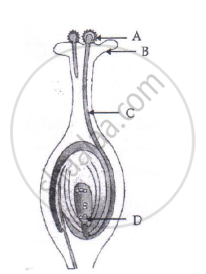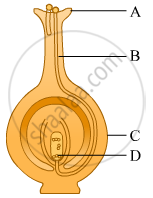Advertisements
Advertisements
Question
Fill in the blanks and rewrite the completed statements:
Lymph flows in _______________ direction.
Solution
Lymph flows in one direction.
APPEARS IN
RELATED QUESTIONS
A student was asked to observe and identify the various parts of an embryo of a red kidney bean seed. He identified the parts and listed them as under:
I. Tegmen
II. Testa
III. Cotyledon
IV. Radicle
V. Plumule
The correctly identified parts among these are
(A) I, II and III
(B) II, III and IV
(C) III, IV and V
(D) I, III, IV and V
How does fertilisation occur in flowers? Name the parts of the flower that develop into (i) seed, and (ii) fruit after fertilisation.

(i) Name the part marked 'A' in the diagram.
(ii) How dose 'A' reachese part 'B'?
(iii) State the importance of the part 'C'.
(iv) What happens to the part marked 'D' after fertilisation is over?
Give one example of a unisexual flower.
Draw a neat sketch of the stamen of a flower. Mark in it filament and anther.
What is made in ovary of a flower?
What is seed? What are the parts of a seed? Explain with the help of a labelled diagram.
The flask-shaped organ A at the centre of a flower is surrounded by a number of little stalks B having swollen tops which lie just inside the ring of petals.
(a) Name A. What are the various parts of A?
(b) Which part of A contains gametes?
(c) Name B. What is the swollen top of B known as?
(d) What does the swollen top of b contain?
(e) Out of A and B, which one is (i) male part, and (ii) female part of the flower?
Fill in the blank by selecting suitable word:
A flower bearing only male or female parts is known as __________ flower.
Fill in the blanks:
A carpel consists of ________ , ________ and ________.
Mention the function of Flower.
Mention the function of Anther.
What are the male and female gametes in a flowering plant?
You have to perform the experiment, "To identify the different parts of an embryo of a gram seed." Describe the procedure that you would follow.
Identify A, B, C and D in the given diagram and write their names.
(a) Identify A, B and C in the given diagram and write their functions.
(b) Mention the role of gamete and zygote in sexually reproducing organisms.
Draw a diagram of a pistil showing pollen tube growth into the ovule and label the following:
Pollen grain, male gamete, female gamete, ovary.
Distinguish between unisexual and bisexual flowers giving one example of each. Draw a diagram showing process of germination of pollen grains on stigma and label the following parts:
(a) Female germ cell
(b) Male germ cell
(c) Ovary
Describe an activity to demonstrate phototropism.
List any two differences between pollination and fertilisation.
Sketch the labeled diagram:
Flower with its sexual reproductive organs
What is pollination? Mention its types.
Differentiate between self-pollination and cross-pollination.
Bisexual : Hibiscus : : Unisexual : ___________
Write the functions of sepals
Draw a neat and labelled diagram.
Double fertilization in angiosperms
The male reproductive part of a flower is ______.
Where does the endothecium layer of anther lobes is present?
Sperm and egg nuclei fuse due to ______.
Pollen grains are produced by ______
Give reason for the following:
Fertilization cannot take place in flowers if pollination does not occur.
Draw the diagram of a flower and label the four whorls. Write the names of gamete producing organs in the flower.
Trace the path a male gamete takes to fertilise a female gamete after being released from the penis.
State the number of sets of chromosomes present in a zygote.
Give any two examples of agents of pollination.
What is the function of calyx?
Explain the post fertilization changes that occur in the ovary of a flower.
